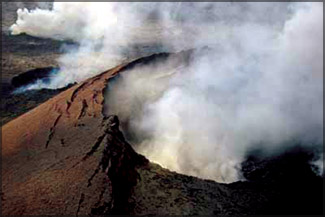 How volcanoes are formed How volcanoes are formed
Volcanoes have been an interesting phenomenon of Earth to study, and
apart from that, this has been a major occurrence which has inspired
film makers. However, it is a known fact that these can turn out
extremely deadly and it would be worthwhile to know how these are formed
although we are not prone to volcanic eruptions in our country. We have
dealt with this topic in one of our earlier issues too.
Generally speaking, volcanoes are a natural way for the Earth to cool
off. Whatever the cause maybe, there are few basic steps which can be
seen when a volcano is born. basic steps which can be
seen when a volcano is born.
First point to note is that magma, a semi-solid hot rock, which lies
in the centre of the globe, is responsible for all this chaos. Pieces of
rocks break off from the rocky layer above the magma and mix into the
magma.
This produces a gas, and the gas filled magma then rises towards the
Earth's surface from the upper mantle and goes into the magma chamber
about two miles from the surface, which is like a huge bucket that holds
all the hot materials.
If you are wondering what the mantle is, it is the region between the
core and crust of the Earth and the Earth plates reside above it. The
hot magma continues to put pressure on the Earth's crust and finally
finds a weak point, and comes out of the weakest point.
The lava flows out, and when it is cooled over time, a cone shaped
volcano is created.
How volcanoes are triggered
Generally there are three main phenomena which trigger volcanoes.
They can happen in subduction zones and divergent boundaries. These are
related to the plates of the Earth and we looked at these in some of our
earlier editions. They can also take place in regions known as Hot
Spots.
Subduction zones
A volcano is formed when Earth plates hit each other. In a subduction
zone, one of the plates goes under the other. This causes the Earth to
heat, and it melts the rock into magma and gases.
  This can happen as deep as 100 miles below the Earth's surface. The
magma produced, settles in pools or chambers near the surface. lThis
causes pressure to build up due to heat and an eruption can take place. This can happen as deep as 100 miles below the Earth's surface. The
magma produced, settles in pools or chambers near the surface. lThis
causes pressure to build up due to heat and an eruption can take place.
Divergent boundaries
Apart from plates hitting against each other, volcanoes can also be
formed when the plates go away from each other. This makes weak regions
in the surface and as a result magma pushes up and lava forms. These
types of volcanoes are found on the ocean floor.
Hot spots
The majority of earthquakes and volcanic eruptions occur near plate
boundaries, but there are some exceptions. For example, the Hawaiian
Islands, which are entirely volcanic, have formed in the middle of the
Pacific Ocean more than 3,200 km away from the nearest plate boundary.
How do the Hawaiian Islands have volcanoes being in the middle of a
plate?
The volcanoes around Hawaii are not created by tectonic plates, but
due to something called hot spots. Hot spots are places that have
extreme heat in the mantle. This heat causes magma to bubble and move to
the surface. Hawaii, Iceland, and Yellowstone are examples of hot spots.
Interestingly, hot spots also record changes in plate motions because
these spots do not move since they are below the plates and therefore
remain in fixed locations for tens of millions of years.
The Hawaiian volcanic ridges are in a line since the plate has moved
over the hot spot over millions of years and the extreme heat has given
birth to volcanoes in regions above it.
The current theory
There was no proper theory for a long time, but now a mathematical
model has been made by geologists and geophysicists and they have come
up with a set of really close facts and figures to predict volcanic
behaviour. Researchers have developed this model, focusing more on how
the gas filled magma would behave near the Earth's surface and whether
lava would pour out on the surface.
 All the steps which we considered above take up rather a long time
and depend on many factors, and researchers have tried to take
everything into account. According to their calculations, the gas filled
magma rises up from the depth of 100 to 200 kilometres at the rate of
1.2 to 2.4 centimetres per year, and it can burst out to the surface
from the depth of about 30 kilometres. All the steps which we considered above take up rather a long time
and depend on many factors, and researchers have tried to take
everything into account. According to their calculations, the gas filled
magma rises up from the depth of 100 to 200 kilometres at the rate of
1.2 to 2.4 centimetres per year, and it can burst out to the surface
from the depth of about 30 kilometres.
Therefore if things happen this way, it would take from 2.9 to 14.2
million years for a volcano to form on the Earth's surface since its
birth within the Earth, depending on the depth and the speed. This
suggests that volcanoes we have today have a very old history.
Thanks to these latest discoveries, predictions can be made of the
birth of volcanoes several million years in advance.
Aravinda Dassanayake |
